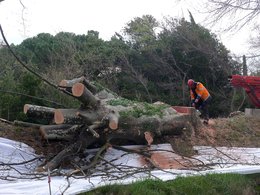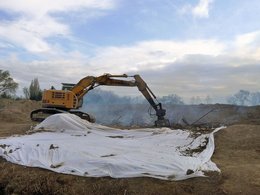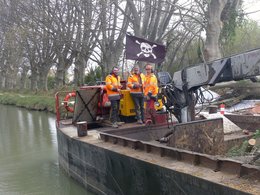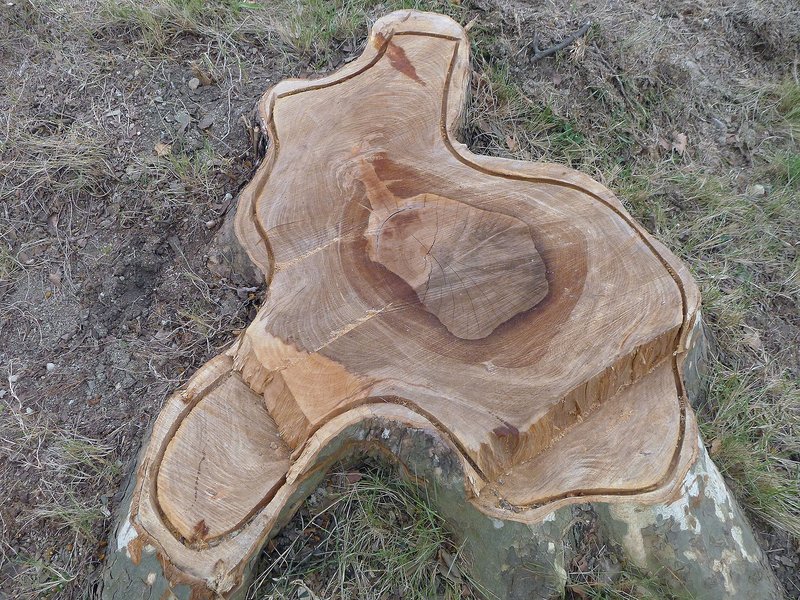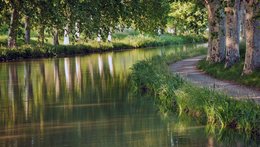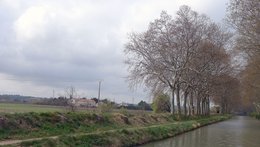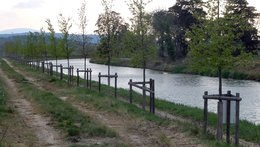In the search for alternative tree species as an answer to climate change, plane trees are also being mentioned repeatedly. The reason for this is their expected versatility and resilience to changing climatic site conditions. However, there are such considerable risks, especially from canker stain of plane (Ceratocystis platani), that planes should currently not being considered a serious option in forestry.
We do not have to look too far back into the past to see that when the climate changes, the tree species composition of forests also changes. Major climatic changes have thus been responsible for all documented changes in the tree species spectrum since the end of the Ice Age - in interaction with the different rates of receding of the tree species.
Against this background, it is illusory to assume that the ongoing changes in the climate could continue without impact on the tree species composition of forests. It can in fact currently be assumed that the speed and magnitude of the projected changes will have an impact even within current forest planning periods on the suitability of the tree species familiar to us today.
If we wish to be able to plan the future development of our forests, we must be in a position to accurately assess the adaptation potential of today's main tree species to climate change. In this context, model-based methods in which the effects of different climate scenarios can be processed quantitatively appear particularly promising. One example of this is the procedure developed in Baden-Württemberg in which the so-called “Baumarten-Eignungskarten 2.0“ („Tree Species Suitability Maps”) are derived on the basis of models, taking various criteria into account. They are currently available for the main tree species Norway spruce, silver fir, European beech, and sessile oak.
It is becoming clear that for the further development of adaptable forests in the medium to long term, it might make sense to include other options in addition to today's main tree species. In addition to examining other provenances and less common native tree species, it appears also sensible to include non-native tree species in our search spectrum.
In this context, reference is occasionally made to plane trees, as their relative versatility in terms of site and climatic conditions promises a certain potential in times of climate change. However, there are notable risks from harmful organisms, which have a serious impact on the assessment of their suitability. Diseases caused by fungi play a significant role here, especially canker stain of plane.
Canker stain of plane: pathogen and course of the disease
Canker stain of plane is caused by the fungus Ceratocystis fimbriata platani (Syn.: C. platani). It penetrates via bark injuries or through root grafting into the wood and is distributed throughout the tree via the vessels. Since the fungus survives for months in the wood, the disease can also be spread with sawdust, wood and root particles.
The first signs of disease are sparse crowns with yellowing leaves. Affected parts of the bark sink in and turn brownish purple. Areas of discoloured bark develop on the trunk, forming flame-like shapes towards the base of the crown. Under the infected bark, the bast and wood turn blackish brown, and the discolouration continues through to the core of the trunk.
The cause is a vascular disease (tracheomycosis); similar to C. ulmi or C. novo-ulmi in Dutch elm disease, or C. fagacearum in American oak wilt. The disease is typically acute. Infected plane trees usually die within one to two years.
The natural distribution area of the fungus is North America, where it occurs together with the occidental or western plane tree (Platanus occidentalis; “American sycamore"), which is also native there. The first description of the fungus in 1929 also came from North America.
The pathogen has been accidentally introduced into Europe in 1945 in the wood of ammunition boxes arriving from the US in Marseilles. From there it spread throughout southern France (Fig. 1), causing massive damage. Sadly, the disease has achieved notoriety as a result of the tragic extent of the infection of the avenue of plane trees lining the Canal du Midi (see INFO below).
In the meantime, the fungus has also spread to areas bordering France, first to Spain and Italy (first recorded in Tuscany in 1972), and later into Switzerland. It is known to have been present in Ticino since 1986. North of the Alps, canker stain of plane was first detected in Geneva in 2001. Since further new infestations were identified shortly afterwards in the canton of Geneva in 2002 and 2003, it can be assumed that the fungus has been spreading ever since north of the Alps.
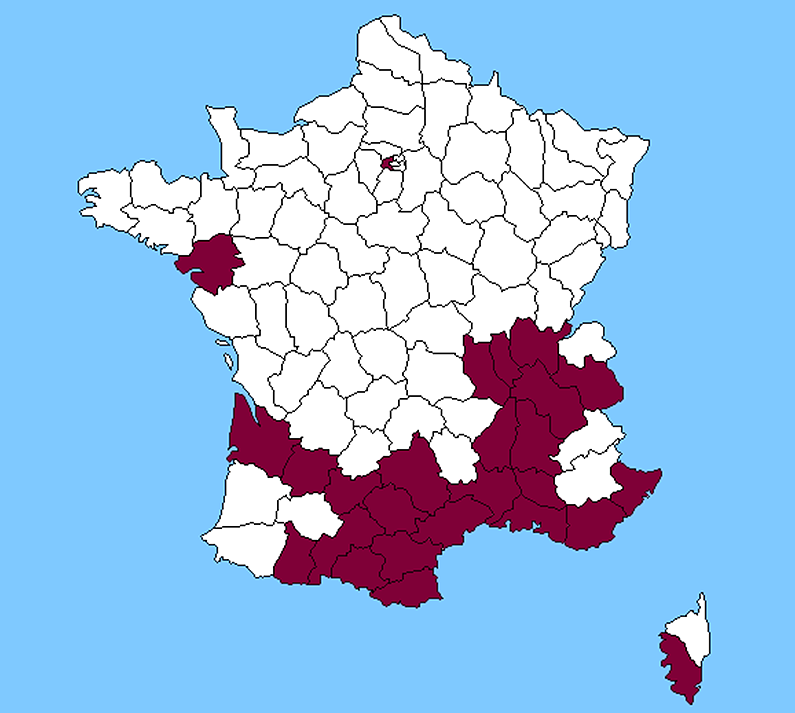
Fig. 1: Distribution of canker stain of plane in France (status in 2019). Source: Ministère de l'Agriculture et de l'Alimentation; 16.10.2019)
Vulnerability of plane trees
In Europe, the oriental plane (P. orientalis) is highly vulnerable to canker stain. And the maple-leaved plane tree, P. acerifolia (Syn.: P. x hispanica; a hybrid of P. orientalis x occidentalis), which is traditionally widely planted here, is also massively affected.
P. occidentalis is thought to have a better potential to resist canker stain due to the co-evolution of host and pathogen in its North American distribution range. However, in P. occidentalis, leaf browning (syn: leaf/twig blight, plane anthracnose) causes major problems. This is another fungal disease, caused by the pathogen Apiognomonia veneta, originally from P. orientalis, which has appeared since the beginning of the 19th century and has largely decimated the populations of P. occidentalis in Europe.
Gegenmaßnahmen
Effective means of treating the canker stain pathogen directly or of curing infected planes are not known. Only preventive measures are possible. On the one hand, it is important to avoid bark injuries, as these - along with root grafting - are the most common points of entry for the pathogen. In addition, the infection pressure on healthy planes should be reduced as far as possible by consistently removing diseased trees.
Specific and detailed practical instructions for dealing with infected plane trees have been developed in France as a result of the painful experiences they have made there with canker stain (available in French, PDF, 2MB). The most important measures are:
- Consistent disinfection of all tools; necessary after working on infected plane trees, on planes with suspected infections, or on symptom-free planes growing in areas with infection risks.
- Rapid and consistent removal of plane trees with symptoms. In order to prevent further spread of the pathogen, all plant parts and the sawdust must be burnt on site immediately after felling (Fig. 2). Under no circumstances may logs, firewood, wood chips or contaminated soil be moved elsewhere.
- It is also strongly recommended that rootstocks are cleared and burnt. However, as this often comes up against technical limits, a “devitalisation” of stumps remaining in the soil is sometimes carried out instead in France. For this, a groove is cut around the outer edge of the surface of the stump using a chainsaw. A plant protection product - approved for this purpose in France - is then introduced into the groove (Fig. 3).
- When felling diseased trees, it is recommended that symptom-free, directly neighbouring plane trees are also removed if possible, in order to contain the spread via root grafting.
However, the development along the Canal du Midi in particular shows that the spread of canker stain of plane trees unfortunately cannot be prevented effectively, despite the consistent implementation of these measures. At best, a delay in the rate of spread and a (slight) reduction in the level of damage seem possible.
And the moral of the story:
Even in times of climate change - there’s no gain in plane with canker stain!
INFO: Plane tree tragedy along the Canal du Midi
Fig. 4: The plane trees of the Canal du Midi; left: intact gallery (before canker stain); centre: the pitiful remnants after infection with canker stain; right: in many places, complete replanting is necessary - with different tree species to be on the safe side. (Photo left: www.locaboat.com; photos middle & right: FVA/U. Kohnle)
The Canal du Midi in the south of France runs from the Mediterranean (Sète) to Toulouse, and is directly connected to the Atlantic (Bordeaux) from there via the Canal latéral à la Garonne. The canal was built in the 17th century by order of Louis XIV, and under the supervision of Pierre-Paul Riquet, who played a major role in financing it, contributing almost his entire not inconsiderable family fortune.
The canal is 240 km long, and attracts millions of visitors every year. The most impressive way to experience the canal is surely by barge. It is true that getting through the first lock may be quite a challenge for freshly initiated crews. Once the crew has survived this test, however, the canal is a delight for the rest of the journey.
The hydraulic engineering installations, revolutionary at the time of their construction, are well worth seeing: its 63 locks, 136 bridges and 55 aqueducts make the canal a UNESCO World Heritage Site. The canal is lined by picturesque villages and medieval towns steeped in history. Particularly impressive is the picturesque, crenellated Cité de Carcassonne, which towers over the canal - another UNESCO World Heritage Site.
Until recently, the galleries of plane trees lining the canal were also a very special attraction. They were planted mainly at the turn of the 18th to 19th century, and have developed over the centuries into a fascinating natural/cultural heritage that gives the canal its character (Fig. 4; left). That is until the arrival of the canker stain radically changed the appearance of the canal in recent times:
The disease was observed for the first time along the canal in 2006, and it has been spreading rapidly ever since. Of the 42,000 plane trees along the canal, well over 20,000 had to be cut down between 2006 and 2017 as a result of the disease; in 2017 alone over 3,000. And - despite all the countermeasures taken - the disease has continued to progress since then. Today, it is mostly only pitiful remnants that bear witness to the former glory of the galleries (Fig. 4, centre).
New trees are continuously being planted to replace the dead plane trees - using other tree species, of course (Fig. 4, right), but it will nevertheless be decades before the gallery character of the pre-canker era is re-established. Until that happens, the traces of the canker will remain visible in the landscape. It is still more than worth a (boat) trip - but quite different from not even 20 years ago.

